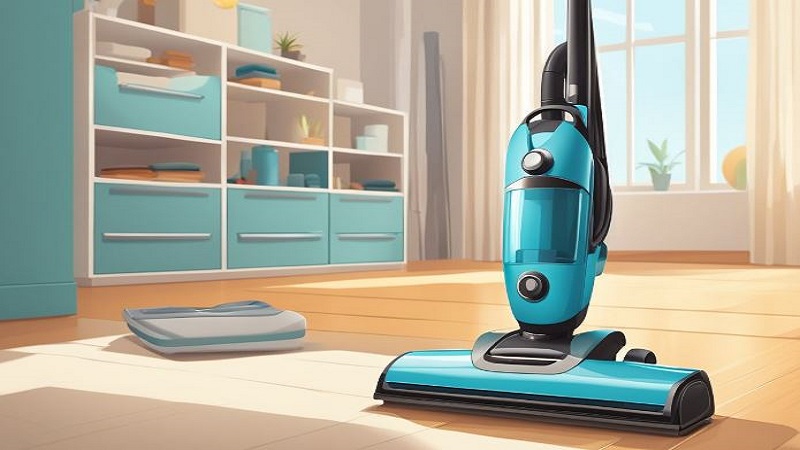Maintaining a tidy home can often feel like an overwhelming task, especially with busy schedules. The good news is, keeping your home neat doesn’t have to take up too much of your time or energy. Simple, daily habits and little changes in routines can make a significant difference in how effortlessly you can enjoy a clutter-free living space.

Implementing a few strategic habits, such as making the bed each morning and doing a quick clean-up before bed, goes a long way. Organizing tools like laundry baskets in each room and designating specific areas for common items can help keep things orderly without much thought.
Incorporating these habits into your daily routine can dramatically reduce the amount of time you spend tidying up, leaving you with a clean home and more time to enjoy other activities.
Key Takeaways
- Establish simple cleaning routines to maintain tidiness.
- Utilize smart organizing solutions to reduce clutter.
- Daily resets keep the home consistently clean with minimal effort.
Establishing Simple Cleaning Routines
Creating a cleaning routine that incorporates daily habits, a weekly schedule, and quick tasks can save time and maintain a tidy home. By integrating these habits into a minimalist lifestyle, you can boost productivity and keep your living spaces clean with minimal effort.
Developing Daily Cleaning Habits
Daily cleaning habits are essential for maintaining a clutter-free and tidy home. Simple actions like making the bed each morning can set a positive tone for the day. A tidy bed contributes to a sense of order in the bedroom, offering a peaceful space to return to at night.
Washing dishes immediately after use prevents clutter from building up. This habit ensures that the kitchen remains clean and organized. In the bathroom, keeping a cloth handy for quick cleanups can make a significant difference. Wipe down surfaces daily to prevent grime and maintain a fresh appearance.
These small, consistent actions can be seamlessly integrated into an evening routine, which can further streamline housework and maximize efficiency.
Weekly Cleaning Schedule
A weekly cleaning schedule is key to tackling tasks that don’t need daily attention. Spreading chores throughout the week can make them more manageable. For example, designate Mondays for kitchen deep cleaning. This could involve wiping down countertops, appliances, and cleaning the sink.
Bathrooms might be reserved for Tuesday. Spend 15 minutes scrubbing the toilet, sink, and shower. This focused effort ensures these high-use areas remain hygienic and fresh.
Another example could be dedicating a day to vacuuming or sweeping common areas. By distributing tasks across different days, the workload feels less overwhelming and the home remains consistently clean.
The One-Minute Rule
The one-minute rule is a powerful technique for maintaining cleanliness. If a task takes less than a minute to complete, do it immediately. This mindset helps prevent small tasks from piling up and becoming daunting.
For instance, putting away shoes or hanging a coat right away, instead of leaving them around, keeps entryways clear. Similarly, quickly wiping down the stovetop after cooking prevents grease buildup.
By addressing these minor tasks instantly, it promotes tidy habits and a cleaner, more organized home. This rule can significantly contribute to a minimalist lifestyle that prioritizes efficiency and simplicity.
Smart Organizing Solutions

Effective organizing strategies can make maintaining a tidy home much easier. By incorporating decluttering essentials and using containers and storage solutions, you can keep your space functional and neat.
Decluttering Essentials
Decluttering is the first step towards a tidy home. Begin by sorting items into categories: keep, donate, and discard. It’s crucial to be honest about what you use and need. Discarding unnecessary items reduces clutter and creates more space.
Adopt the “One-In, One-Out” rule. For every new item brought into the home, another should be donated or discarded. This prevents accumulation and maintains balance. Regularly scheduled decluttering sessions, such as monthly or seasonally, help maintain order.
Review and edit your wardrobe and pantry regularly. Donate clothes you haven’t worn in a year and discard expired food items. This practice not only frees up space but also makes it easier to locate items quickly. Implement a labeling system for easy identification and categorization.
Using Containers and Storage
Containers and storage solutions play a vital role in home organization. Clear bins are perfect for pantry items, allowing you to see contents at a glance. Use stackable containers to maximize vertical space in cabinets and closets. Labels on containers further enhance organization by clearly identifying contents.
Wall-mounted storage options help keep things off the floor. Shelves, hooks, and pegboards can transform any wall into valuable storage space. For example, wall-mounted baskets are great for organizing mail, keys, and other small items.
In the wardrobe, consider using dividers for drawers and shelves. This helps keep clothing and accessories neatly separated and easy to find. Investing in multi-purpose furniture, such as ottomans with hidden storage, adds style and functionality to any room. Keeping items categorized and contained reduces clutter and fosters a tidy, efficient living space.
Creating a Healthy Home Environment

Maintaining a healthy home environment involves cleanliness in all living spaces, encouragement of good habits among family members, and ensuring plenty of fresh air and sunlight.
Encouraging Cleanliness Among Family Members
Getting the entire family involved in maintaining a tidy home is crucial. Assigning specific tasks ensures accountability and spreads responsibility evenly.
Create a chore chart that includes tasks such as wiping surfaces, putting away items, and keeping shared spaces like the living room clutter-free. Younger children can help with simpler tasks like picking up toys.
Setting clear expectations and leading by example encourages everyone to participate. Regularly remind family members to wash their hands to reduce bacteria spread, promoting both cleanliness and physical health.
Maintaining a Clean Kitchen and Bath
The kitchen and bathroom are essential areas for maintaining health due to their frequent use and potential for bacteria buildup.
In the kitchen, wipe down surfaces immediately after use, and clean as you go while cooking to prevent clutter. Store items properly to keep countertops clear. Keeping a cloth handy can make quick cleanups effortless.
In the bathroom, a daily wipe-down of surfaces, including the sink and toilet, reduces germ spread. Hanging towels to dry after each use prevents mildew. Keeping cleaning supplies accessible encourages regular maintenance without a lot of effort.
The Importance of Fresh Air and Sunlight
Fresh air and sunlight are vital for a healthy home environment. They help reduce indoor pollutants and bacteria, contributing to better physical health.
Open windows daily to allow fresh air circulation. This practice can significantly improve the air quality in living spaces such as the bedroom and living room. Placing plants around the home can also enhance air quality by absorbing carbon dioxide and releasing oxygen.
Sunlight not only brightens up rooms but also has natural disinfecting qualities. Ensure window coverings are open during the day to let sunlight in, particularly in areas prone to dampness like the bathroom and kitchen.
Effortless Cleaning Techniques and Tools
Maintaining a clean home doesn’t have to be time-consuming or labor-intensive. With the right techniques, tools, and a few smart strategies, anyone can keep their living space tidy with minimal effort.
Cleaning Hacks for Efficiency
One of the easiest ways to stay on top of cleaning is to clean as you go. By addressing small messes immediately, such as wiping down counters after use or putting items back in their place, the need for major cleaning sessions is reduced.
Using natural cleaning solutions can simplify the process. For instance, mixing baking soda and lemon juice creates an effective cleaner for microwaves and other surfaces. Allow the mixture to steam in the microwave for a few minutes to loosen grime.
Multitasking while waiting for something can save time. For example, while waiting for the laundry to finish, take a few minutes to tidy up living areas or wipe down windows.
The Best Cleaning Supplies
Choosing the right cleaning supplies can significantly streamline household chores. Essential items include a reliable vacuum for floors and carpets, a mop for hard floors, and a set of microfiber cloths for dusting.
For stains and spills, keeping a no-rinse floor cleaner on hand is beneficial. Use a squeegee to quickly clean windows and mirrors without leaving streaks.
Natural cleaners such as vinegar and baking soda are versatile and non-toxic, making them ideal for various surfaces around the home. A sturdy laundry basket can simplify the laundry routine by organizing clothes, ready to be sorted and washed.
Leveraging Technology for Cleaning
Incorporating modern technology into cleaning routines can make a big difference. Robot vacuums are a great example, autonomously cleaning floors and carpets, even in the owner’s downtime.
Smart washing machines offer advanced cycles that optimize water and energy usage, resulting in cleaner clothes with less effort. Using these machines, combined with an efficient laundry routine, ensures that laundry is managed seamlessly.
Automated mops can also help keep hard floors spotless, working while homeowners attend to other tasks. Technological tools, paired with effective cleaning hacks and supplies, make maintaining a tidy home easier than ever.
By integrating these effortless cleaning techniques and tools into their routines, anyone can achieve a consistently clean and inviting living space.
The Ultimate Effortless Cleaning: Hiring a House Cleaning Service
While the cleaning hacks and tools mentioned above are great for everyday maintenance, sometimes you need a deeper, more thorough cleaning. If you’re short on time, overwhelmed by clutter, or simply want to give yourself a break from chores, a professional house cleaning service can be a game-changer.
They can handle everything from deep cleaning carpets and upholstery to scrubbing bathrooms and kitchens, leaving your home sparkling and allowing you to focus on the things you enjoy.
Frequently Asked Questions
Maintaining a tidy home with minimal effort involves incorporating small but effective habits. Specific strategies like the 30-minute cleaning rule, minimalist cleaning techniques, and routine organization can significantly reduce housework.
1. What are the essential daily tasks for keeping a clean home with minimal effort?
Daily tasks such as wiping down surfaces after use, running the dishwasher, and a quick sweep of high-traffic areas can maintain cleanliness. Keeping items in their designated places and making the bed every morning also contribute to a consistently tidy home.
2. How can one implement the 30-minute cleaning rule effectively?
Set a timer for 30 minutes and focus on one area of the home. Prioritize tasks by starting with the most cluttered spaces. Incorporating this rule into your daily routine ensures that cleaning doesn’t become overwhelming and keeps the house consistently tidy.
3. What minimalist cleaning strategies lead to a consistently tidy home?
Adopting the one-touch rule—where you put items away immediately after use—keeps clutter at bay. Using labeled storage containers and committing to a daily reset of living spaces can simplify the cleaning process and maintain order effortlessly.
4. What are the common obstacles to maintaining a clean home and how to overcome them?
Procrastination and lack of time are common obstacles. Overcome these by setting small, manageable goals and creating a cleaning schedule. Engaging in short, daily cleaning sessions can make the task less daunting and more manageable.
5. How can routine organization help in reducing housework over time?
Regular organization ensures that everything has its place, reducing the time spent searching for items or cleaning up clutter. Implementing habits like a nightly tidy-up and maintaining labeled storage can streamline household tasks and minimize mess.
6. What tips can make house cleaning more efficient for busy individuals?
Busy individuals can benefit from keeping cleaning supplies within reach, tackling one room at a time, and breaking tasks into small chunks. Setting specific times for quick cleaning sessions and enlisting help from household members can also increase efficiency.
